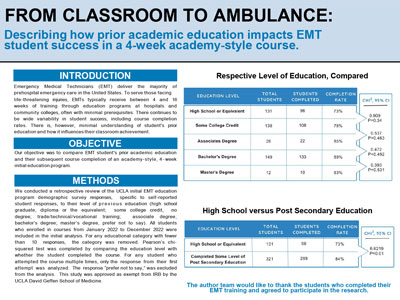ABSTRACTS
From Classroom to Ambulance: Describing How Prior Academic Education Impacts EMT Student Success in a 4-Week Academy-Style CourseAuthor: Michael Kaduce, MPS, NRP Associate | | Associate Authors: Taggart Diehl, BS, NRP
Introduction Emergency medical technicians (EMTs) provide most of the prehospital emergency care in the United States. To serve those facing life threatening injuries, EMTs typically receive between 4 and 16 weeks of training through education programs at hospitals and community colleges, often with minimal prerequisites. There continues to be wide variability in student success, including rate of course completion. There is, however, minimal understanding of students’ prior education and how it influences their classroom achievement. Objective To compare EMT students’ prior academic education and their subsequent course completion of an academy-style, 4-week initial education program. Methods We conducted a retrospective review of the UCLA initial EMT education program demographic survey responses, specific to self-reported student responses to their level of education (high school graduate, diploma or the equivalent; some college credit, no degree; trade/technical/vocational training; associate degree; bachelor’s degree; prefer not to say). All students who enrolled in courses from January 2022 to December 2022 were included in the analysis. For any educational category with fewer than 10 responses, the category was removed. A Pearson’s chi square test was performed comparing student education level and course completion. For any student who attempted the course multiple times, only the response from their first attempt was analyzed. The response “prefer not to say” was excluded from analysis. Results A total of 466 student responses to the demographic survey from 12 classes were included in the analysis. When each education level was compared with the next respective higher education level, there was no statistical significance. Having some level of college education up to a bachelor’s degree, however, was statistically significant in completing the EMT course when compared to high school graduate, diploma, or the equivalent (x2 = 6.62, p = 0.01). Discussion: Students with prior postsecondary education are more likely to complete the EMT course. As a traditionally entry-level position, academic prerequisites have historically not been required. While further study is needed, EMT programs should consider whether some college-level prerequisites would improve classroom success.
|

